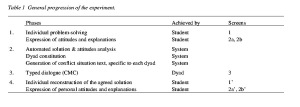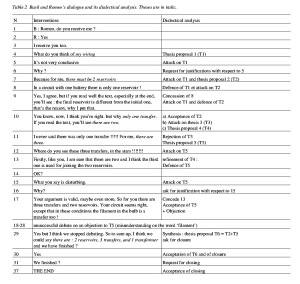ISSA Proceedings 1998 – Conditions For Spontaneous Production Of Computer-Mediated Argumentative Dialogues Between Learners
No comments yet 1. Introduction
1. Introduction
This research aims to experiment the conditions for spontaneous production of argumentative dialogues between learners, in problem-solving situations. Since relatively little research has been carried out in this field of research, this paper proposes a restricted set of hypotheses, from both theoretical and practical points of view, on the conditions under which such discussions can be produced. A computer-based environment, involving synchronous typewritten communication, has been implemented in order to test these hypotheses, and to collect a corpus of argumentative interactions that is adapted for the validation of a cognitive model of this type of interaction. Preliminary analyses of the corpus gave quite encouraging results.
Up to the present date, some research in the field of cooperative learning has been carried out on the role of dialogic interactions in the processes of concept acquisition or comprehension (e.g. Thorley & Treagust 1987 ; Baker 1996). However, much less research relates to the study of the conditions under which argumentative interactions are produced between learners. Golder (1996) carried out research on young pupils’ criteria for obtaining argumentative texts (the task was to compose a coherent text, while arguing successively in favour of two conflicting points of view, with respect to a particular question). Other research has been carried out on the design of computer-based environments, using computer mediated communication (CMC) for promoting certain types of interaction, by a suitably structured dialogue interface (Baker & Lund 1997). All of this research shows, that the conditions for producing argumentative dialogues are very diverse, including for example cognitive, social aspects as well as the design of the interface itself. The approach described here is practical as well as theoretical, the main aim being to collect a corpus of argumentative dialogues within a cognitive modelling framework.
This paper presents a experimental situation, designed for the production of argumentative dialogues, by computer mediated communication (CMC), between learners, on a specific problem-solving task in physics : the elaboration of simple qualitative models of energy (“energy chains”, Tiberghien 1994). Once this work has been situated in the framework of research related to argumentation modelling, the hypotheses and modelling constraints that contribute to the elaboration of the experiment are exposed. Then a corpus sample is given, that includes a CMC discussion of one dyad and the individual attitudes of the two participants, just before and just after the interaction. In conclusion, some qualitative preliminary results are given, related to the evaluation of the situation with respect to its original aim : provoking spontaneous argumentative dialogues.
2. Research project
The work described here is situated within the research framework of a PhD thesis in cognitive science, the aim of which is to investigate the cognitive changes (specifically, changes in attitudes) of learners that result from engaging in argumentative dialogues. As part of this work, a computational model based on artificial intelligence techniques is currently under development (Quignard & Baker 1997). The model comprises two belief sets (Doyle 1979) imbedded in two artificial agents, whose dialogue is based on a dialectical model of argumentation (Barth & Krabbe 1982) using multifunctional communicative acts (Bunt 1989).
From a methodological point of view, this cognitive modelling approach requires collecting specific empirical data, for validation of the model. This data must include a dialogue corpus, containing modellable argumentative phases, and give access to the participants’ attitudes at the boundaries of these phases. Since that kind of corpus is not naturally available, a specific experimental situation has been designed and implemented for this purpose.
3. Design hypotheses and modelling constraints
Preliminary remarks
Previous corpora analyses of problem-solving dialogue between learners confirmed what teachers have always known : students are not naturally likely to argue spontaneously with each other, at least with respect to the subjects taught in school. It may also be observed that interpersonal conflicts or individual contradictions are not sufficient to provoke the incidence of argumentation, nor the incidence of argumentative attitudes. Nonnon’s work (1996) partially explain this phenomenon : concepts that are not yet sufficiently mastered (since they are being elaborated, and learned) will not allow students to take risks to defend or attack them.
Our investigations on the situations promoting spontaneous argumentative interactions between learners are structured on one hand by pragma-dialectical and psychological hypotheses, and on the other hand by some modelling constraints, in order to collect the expected data.
Pragma-dialectical hypotheses
The design of a situation where the interpersonal relationships between participants may hopefully lead to an argument, is based on the following pragma-dialectical hypotheses (van Eemeren & Grootendorst 1983, 1992).
– Conflict must be externalised: disagreement must be openly declared, so that personal positions are known and established.
– Some common ground must exist : conflict resolution by verbal means depends on sharing a common language (at least to some extent).
– Participants must agree on the authorised rules to resolve their conflict, legal moves for attacks and defences and rejected fallacies (Walton & Krabbe 1995).
Psychological hypotheses
Golder (1996) summarises the major obstacles for students to in understanding an argumentative situation. She defines three spaces, that must be wide enough to leave space for an argumentative debate:
– the referential space : students must be able to grasp the concepts that are to be discussed. This referential space may be quite narrow when subjects are students, since these concepts are being elaborated (Nonnon 1996).
– the cognitive space : subjects have to be able to build their own opinions and to understand that other attitudes may also be adopted. The cognitive space represents the ability to apprehend opinions with respect to a given problem.
– the production space : subjects have to be able to, and be allowed to, express their opinions in the current situation. For example, certain types of debate cannot take place at school, or with some persons. The dialogue situation may present physical obstacles to the discussion.
The first hypotheses manifest the need for a preliminary task, that may help students to grasp the concepts of the main task, and to step back in order to apprehend attitudes, differences of opinions and contradictions. The last hypothesis warns of the advantages and disadvantages of a computer-mediated typewritten discussion. Although such communication channels may facilitate control of emotions or dissimulation, and give more time for reflection (typewritten discussions are much slower than spoken ones), they also impose a particular way of representing concepts (typewritten language), that may be a semiotic obstacle to reasoning. In the current case, solutions can better be presented by diagrams than by language, and drawings cannot be produced on-line.
Modelling constraints
Modelling argumentative dialogues in conjunction with changes in the participants’ attitudes makes strong constraints on the situation in which a suitable corpus can be collected. Attitudes and explanations have to be collected just before and just after discussion, so that one gets a good representation of the participants’ knowledge, of the attitudes they may hold during the interaction and of the arguments they may use. An external intervention has to be designed at the boundaries of the interaction in order to collect this information, yet it must not alter neither the content nor the progress of the discussion.
A spontaneous emergence of a critical discussion is expected as soon as the appropriate dialogical attitudes have been expressed and the communication between participants’ screens is established. This implies that dyads have already been established, i.e. which students will discuss together in pairs. This does not leave much time to analyse the individual solutions and process a matching algorithm. Since the combinatory space that has to be investigated is very large (105 combinations for 8 students), dyad constitution that is based on analysis and comparison of individuals’ problem solutions needs to be achieved by a computer.
The spontaneous start of the discussion in the argumentative mode also requires avoiding preliminary dialogues, whose goals are to build up the common ground, to externalise the initial conflict, and to set up the initial positions of the participants, since these phases are usually done in a non-argumentative way. These goals must of course be achieved, but for the purposes of modelling this must not be done in the dialogue itself.
Participants are required to discuss only by means of language, excluding other non-verbal forms of communication, such as gestures, facial expressions and diagrams. This may cause a strong handicap when solutions diagrams are to be communicated. Such a requirement is imposed in order to collect the maximum of the communicated information exchanged by participants. In previous corpora, collected by face-to-face interactions, it was very difficult to access the real content of what was communicated.
4. Description of the situation
The choice of a task: energy chains
The choice of the task is a crucial compromise : the main topic is expected to be both debatable (in the sense of Golder, op. cit.) and modellable, i.e. it allows automated analysis and dyad constitution. The task chosen was the qualitative modelling of energy, using by energy chains (Tiberghien 1994 ; Tiberghien & Megalakaki 1995), by high school students (16-17 years old).
Energy chains are composed by the following elements : reservoirs (that store energy), transformers (that transform energy) and transfers of energy (work, heat and light). This task also contains a fundamental syntactic rule : chains must start and finish by a reservoir ; these reservoirs must be different. The experimental situation students have to model is the case of a bulb connected to a battery by the mean of two conducting wires. The correct corresponding chain is given figure 1.
The choice of this task is grounded by the following facts. Firstly, students’ problem solving strategies are now well known for this task (Megalakaki & Tiberghien 1995; Collet 1996 ; Devi et al. 1996). Secondly, the task implies a wide knowledge space for debate, since students have to their disposal several systems of explanation for this phenomenon, and therefore several conflicting positions may be held and discussed (the electrokinetic model proposes a very different solution to this exercise).
Finally, this graphical task is well structured by syntactic rules on a small number of types of elements, which allows automated analysis of students’ solutions. Dyad constitution may be achieved by a computer, in a reasonable processing time (10 minutes maximum).
Successive phases of the experiment
The experiment has been carried out with 8 high school students of a same class, 3 boys and 5 girls, aged from 16 to 18 years old. It involves four main phases : three are achieved by students (alone or in dyad), one is achieved by the system. This is a classical experimental procedure : a pretest, the task, a posttest, and a technical phase, expected the shortest as possible, for the organisation of the central phase (see table 1).
Phase 1: Individual problem solving and attitudes
Description
On a first screen (see figure 2), each individual student must draw the energy chain that models the experimental situation, provided for each student. The experimental situation consists of a battery, a bulb, connected by two electric wires. This material is the same that the students commonly use in labwork.
On this screen, two spaces are available : one graphical window where chain elements can be placed (these boxes and arrows can be manipulated from the menu bar) and one text window, updated by the system, that describes chains in a few sentences, as fast as they are elaborated. They also have a quick access on the screen and on a separate sheet of paper to a description of the model (syntax and semantics of the chain components).
On the second screen (see figure 3), students are proposed sentences (up to ten) by which the system describes their individual solution. Each sentence is displayed in a separate text window, in a column, on the left hand side. On the right of each sentence, students successively find a local menu, from which one of five attitudes can be selected:
1. I’m sure it’s the case. (strong adhesion)
2. Yes, maybe. (weak adhesion)
3. I don’t know. (no commitment)
4. Maybe not/yes. (weak negation or denial)
5. I’m sure, it’s (not) the case. (strong negation or denial)
then a text window, where subjects are invited to type explanations with respect to their attitude.
A third screen (not included in this document), in principle identical to the previous one, displays a more complex description of the solution. It does not describe components separately anymore, but rather “chunks” of the energy chain diagram, composed by two connected boxes and their interconnections, in order to collect more global attitudes and other types of explanations.
Rationale
This phase aims to help subjects to form their own opinions on the solution to the problem, by graphical problem solving (a semiotic register adapted to the problem solving task), followed by an individual reflection within language (the semiotic register adapted to discussion task). Shifting the problem into language is requested to match reasoning to the concept representation modes (Stenning & Oberlander 1995). A new phase of reflection is induced on the current solution, that may improve the rise of a critique, without introducing new concepts nor solution components. The automated description of the diagrams with sentences or groups of sentences also proposes an common way of describing the solutions, that may improve the determination of the common ground, before the discussion starts.
Phase 2: Dyad constitution
An automated algorithm has been implemented for dyad constitution, so that discussions may start as soon as possible after attitudes have been expressed. During the first phase, no one could know who would discuss with whom. The choice of the partners is achieved on line, on the basis of the individual solutions, in order to put together subjects, who manifested conflictual solutions, that may give rise to potentially rich argumentation. Solutions are analysed, formalised and finally compared.
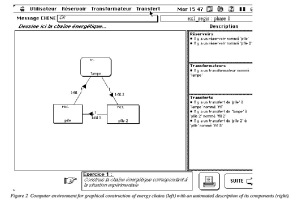
Figure 2 – Computer environment for graphical construction of energy chains (left) with an automated description of its components (right).
Three criteria have been selected in order to predict which pairs of students’ solutions would lead the students who created them to commit themselves to argumentation.
– conceptual obstacle: students should be put together who did not solve the problem the same way. There are three ways of describing the problem (modelling levels, see Tiberghien 1994) : a raw description of the objects involved in the situation (objects level), an electrokinetic model (using knowledge from electrical circuits) and energy modelling (the correct way, expected for this exercise). Research in physics education showed that students’ description are homogeneous from the modelling point of view, and they have difficulties in changing the way that they conceive the problem. Therefore, from this conceptual obstacle one can expect strong positions and entrenched commitments. Modelling levels are estimated on the basis of the labels given to components of the chain, and the number and direction of transfers. These subcriteria are weighted by the degree of belief in the corresponding propositions, as expressed in the attitudes.
– normative obstacle: a chain that does not conform to rules of the model is expected to give rise to well grounded attacks from the opponent (there is a space of possible counterarguments).
– solution correctness: from the principle that a good solution is more convincing than a worse one, one must avoid putting together very inequal solutions, otherwise the worse solution could not compete against the better one. On the other hand, one should also avoid to put together two solutions that obtained a similar mark: they could be so close that there would not be any conflict left, that may lead not to a valuable argumentation, but rather to a negotiation
The argumentative potential of each dyad is evaluated on the basis of the previous criteria, and an “argumentative mark” is given. An optimisation algorithm investigates all possible ways of choosing four pairs in a group of eight subjects, and retains the best configurations: no pair must be too weak, most of them must be
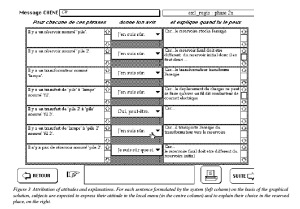
Figure 3 – Attribution of attitudes and explanations. For each sentence formulated by the system (left column) on the basis of the graphical solution, subjects are expected to express their attitude in the local menu (in the centre column) and to explain their choice in the reserved place, on the right.
maximal. In fact, the final choice amongst candidate dyads (e.g. 5 optimal ones amongst 105 possibilities for a group of 8 students) is left to the experimenter’s intuition.
Text generation for each conflict situation
Once the choice of dyads is made, one must give to each dyad specific instructions that lead to an argument. Conforming to the rules of pragma-dialectics and the modelling constraints, instructions consist of a common language description of the conflict situation and this final phrase:
“Discuss together, each of you defending your own point of view, in order to find a common solution to the exercise.”
By the presentation of this text, essential elements of the common ground relating to the conflict situation are established, and positions are declared. Participants cannot visualise the opponents’ diagram: they only have a partial description of it, in common language. The students also have at their disposal their own solution diagram, on a separate sheet of paper.
Phase 3: CMC discussion of the solutions
Once dyads have been constituted, the students sit in front of a computer, so that partners in a given dyad are back to back. Partners share the same computer screen across the network. The connection enables each student to observe all actions of the other, including text as it is being typed.
The screen used for computer-mediated argumentation is divided in two parts (see figure 4). The upper part of the screen displays the description of the conflict situation, and the instruction phrase, described in the previous section. The lower part of the screen is dedicated to communication. Two personal spaces are displayed on both sides of a central dialogue history. Subjects communicate by the use of buttons in their personal space. Some buttons send short messages to the dialogue history : ‘Yes’, ‘No’, ‘I agree’, ‘I don’t agree’… These are shortcuts because typing takes a while ; they are also provided to stimulate their use, and so to structure a certain from of discussion. Other buttons (balloon, ‘Because…’, see figure 4) open a pop-up text window where free text can be typed. The students send their messages by hitting the TAB key. In this case, their message is added to the bottom of the dialogue history (bottom of screen in the middle) and their text dialogue box closes. The design and implementation of the computer-mediated communication part of this interface was based on previous research carried out within GRIC-COAST (Baker & Lund 1997).
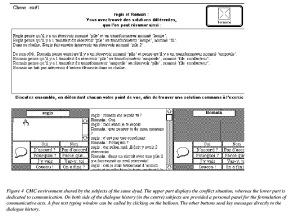
Figure 4 – CMC environment shared by the subjects of the same dyad. The upper part displays the conflict situation, whereas the lower part is dedicated to communication. On both side of the dialogue history (in the centre) subjects are provided a personal panel for the formulation of communicative acts. A free text typing window can be called by clicking on the balloon. The other buttons send key messages directly to the dialogue history.
The shared screen technology induces its own side effects. Subjects have to manage turn-taking and avoid simultaneous typing (overlapping contributions cannot be separated). Subjects do also conform to another implicit social rule, that is not to intrude and use opponent’s personal space: the shared screen technology actually cannot tell which computer provoked events such as key strokes and mouse clicks.
Phase 4: Individual reconstruction of the agreed solution and attitudes
Once students decide that the debate is closed, they call the experimenter to disconnect the screen sharing. Subjects come back to the initial drawing environment for energy chain elaboration (see figures 2 and 3). They are expected to rebuild the energy chain on which they agree at the end of their discussion. As in the first phase, their chain is analysed and descriptive propositions are proposed by the system, on which subjects must express their own attitudes and give explanations.
The design rationale of this phase was that the researcher would be able to access the degree of agreement reached in the discussion, by comparing it with the chains drawn subsequently by individual students of the same dyad. One can also access by the explanations given to new components of the chain, and to the reasons why proposals were accepted or not.
5. Preliminary results
The solutions collected at the end of the first phase were quite similar. Therefore it was not easy to obtain conflictual dyads. Two out of four gave rise to short and weak argumentation. The two others had a better discussion: their solutions had more conceptual differences.
Corpus sample
As an illustration of the preliminary results, we present the work achieved by a dyad, that gave an interesting discussion: Basil and Romeo (the names of the students have been changed). Their initial solutions were quite different, as shown on figure 5.
Initial states
Basil’s reasoning can be reconstructed from his attitudes and the explanations he gave. According to him, the final reservoir was different from the initial one. Therefore he introduced a second battery. Transfers are labelled “wire n”. He was not sure of the third wire, but it was required to bind the two reservoirs. On his side, Romeo qualified the situation to be a “simple electrical circuit” (sic). Between the battery and the bulb he drew two transfers in opposite directions, that he called “conducting wire”. All his attitudes are strongly affirmed.
CMC Discussion
The discussion between Basil and Romeo is presented below (table 2), with a preliminary dialectical analysis. This is not a transcription rather the real content of the students’ communication, as they typed their messages on the screen (although the original was in French). Mouse moves apart, this is the integral informative content exchanged by Basil and Romeo. For the sake of brevity here, contributions 18 to 28 and 32 to 36 have been left out, since they have no consequences for the progression of the discussion. The average contribution duration is two minutes. Debate closed naturally (i.e. by a common decision of the participants) after 71 minutes discussion. Romeo’s interventions are indented to increase the legibility of the dialogue.
Final states
Once communication was cut off, and the students asked to work again individually, Basil and Romeo each rebuilt the common solution on which they agreed at the end on the discussion. As one can see it from table 2, participants agreed on Basil’s solution (circular diagram, with two reservoirs and one transformer). Their final diagrams were identical, except for the labels given to transfers. Instead of the initial “wires”, Basil used the term “transfers”. Romeo kept his original designation (“conducting wires”). This difference may be explained a posteriori by the fact that no thesis really dealt with the name to give to transfers.
The final attitudes were all strongly affirmed, with the exception of Romeo’s attitude with respect to the transfer between the two reservoirs, that remained weakly positive (‘Yes, maybe.’). Basil’s explanations were laconic and similar to the original. On his side, Romeo gave interesting explanations concerning the new components (the “existence” of a second battery and of a transfer between the two reservoirs). He recalled the arguments by which Basil supported those propositions in the dialogue (see table 3).

Table 3: Attitudes and explanations provided by Romeo concerning the two new components appeared in his final chain, after discussion
Preliminary results
On the basis of this preliminary analysis of the corpus, one can only draw qualitative conclusions : preliminary results at least validate the fact that the experimental situation – including automatic translation of graphical solutions into a textual form, automatic solution analysis, conflict situation texts and, above all, dyad constitution – is able to favour the spontaneous production of modellable argumentative interactions between students.
The attitude expression activity was easily achieved by subjects, and allows the experimenter to collect both attitudes and explanations at the key moments of the experiment. Students systematically and carefully filled in all the explanation fields. One could notice interesting changes in the attitudes and explanations before and after the discussion phase. Some new components and therefore new attitudes arose. The corresponding explanations recalled arguments stated in the dialogue. Similarly, these arguments were visible a posteriori in the explanations given by the proponent before the discussion started. The attitude and explanation collection phase provides a good way to rebuild students’ conceptions before and after the dialogue and to relate them to the dialogue statements.
Dyad interactions were mainly argumentative. Very few interventions preceded the proper argumentative phase, and did not involve any new content information relating to the problem-solving task. The aim of these initial interventions was to check whether the interface worked well (subjects did not have any preliminary exercise to get used to this interface). Another informal dialogue occurred at the end of the interaction as well, after the discussion had been clearly closed. In fact, subjects took a while before getting the attention of the experimenter, and their screens remained shared a few minutes more. Argumentation between students could be easily analysed in dialectical terms. Contributions provided easy access to their propositional content, since dialogue turns were well respected and students did not use many referents.
Positive conclusions may be drawn with respect to the quality of students’ discussions. Although there are informal dialogue phases, these do not affect the progress of the main discussion: they can be easily put aside, for the purposes of modelling argumentation dialogue. Therefore, the collected discussion are really argumentative, spontaneously produced, and modellable by a dialectical and cognitive system.
6. Perspectives and conclusions
Success in the spontaneous production of argumentation dialogue depends essentially on the degree of commitment of students to their solutions, and on the conceptual distance between their points of view. In the corpus collected during the experiment presented in this paper, students’ solutions were too similar, or too “classical”, and very much constrained by the electrical model. Further experiments aim to get better argumentative dyads by giving students better information on the energy chain model, so that they understand that a quite different phenomenological description is expected. Hopefully more personal and more diverse solutions could be drawn.
One aim is to improve the way the initial conflict is described and presented to dyads, for setting the basic information and the common ground for the discussion. More linguistic opposition markers can easily be introduced. The instruction phrase may also be improved, to encourage students to have more complex argumentative discussions, if they are for example expected to investigate all the differences between their two solutions. In fact, students estimate that the discussion task is over as soon as the main conflict (the one given in the description text) has been resolved, without taking care of the rest of their chains or leaving undecided components of the chain, like labels.
We plan to collect a second corpus, using an improved version of the experimental situation and its attendant software, with a larger group of students, which would give subjects more chance of having a better opponent.
This paper presented an experimental situation for collecting argumentative dialogues, spontaneously provoked between learners in computer mediated communication. Students’ attitudes and explanations were collected just before and just after the interaction. Fundamental hypotheses have been discussed, that form the basis of the implementation of the experiment and the dyad constitution algorithm. These hypotheses take account of personal argumentative skills (conceptual and cognitive spaces), interpersonal aspects (conflicts and choice of the opponent) and technical features (production space) for structuring the dialogue interface. This experiment produced satisfactory qualitative results on a restricted group of learners. An experiment on a wider group is planned for completing the validation of this protocol and to support our main research project: cognitive modelling of argumentation dialogue.
Acknowledgements
We gratefully acknowledge financial support for this research from the French Ministry of Education, Research and Technology, the CNRS and Université Lyon 2.
Thanks to the students and their physics teacher for participating to the experiment, and to colleagues in GRIC-COAST for their assistance in implementing software (Kris LUND) and in running the experiment itself (Laurence Le DIOURIS and Jacques VINCE).
Finally, thanks to Andrée TIBERGHIEN for her guidance in this research.
REFERENCES
Baker, M. (1996). Argumentation et co-construction de connaissances. Interaction et cognitions 1(2-3), 157-191.
Baker, M.J. & Lund, K. (1997). Promoting reflective interactions in a computer-supported collaborative learning environment. Journal of Computer Assisted Learning 13, 175-193.
Barth, E. M. & Krabbe, E. C. (1982). From Axiom to Dialogue. Berlin : de Gruyter.
Bunt, H. C. (1989). Information Dialogue as Communicative Action in relation to Partner Modelling and Information Processing. In The Structure of Multimodal Dialogue (pp. 53-54), Amsterdam : Elsevier, North-Holland.
Collet, G. (1996). Apports linguistiques à l’analyse des mécanismes cognitifs de modélisation en sciences physiques. Unpublished doctoral thesis in Cognitive Science, Institut National Polytechnique de Grenoble (France).
Cox, R. & Brna, P. (1995). Supporting the Use of External Representations in Problem-Solving : The Need for Flexible Learning Environments. Journal of Artificial Intelligence in Education 6(2/3), 239-302.
Devi, R., Tiberghien, A., Baker, M., & Brna, P. (1996). Modelling students’ construction of energy models in physics. Instructional Science (24), 259-293.
Doyle, J. (1979). A Truth-Maintenance System. Artificial Intelligence 12(3), 231-272.
van Eemeren, F. H. & Grootendorst, R. (1983). The Study of Argumentation. New York : Irvington.
van Eemeren, F. H. & Grootendorst, R. (1992). Communication, Argumentation, Fallacies. Mahwah, N. J.: Erlbaum.
Golder, C. (1996). Le développement des discours argumentatifs. Actualités pédagogiques et psychologiques. Lausanne: Delachaux et Niestlé.
Megalagaki, O., & Tiberghien, A. (1995). Learning modelling through the successive resolution of problems. In Proceedings of the first European Conference on Cognitive Science (ECCS’95), St Malo (France), April 1995, pp. 95-98.
Nonnon, E. (1996). Activités argumentatives et élaboration de connaissances nouvelles : le dialogue comme espace d’exploration. Langue française 112, 67-87.
Quignard, M. & Baker, M. (1997). Modelling Argumentation and Belief Revision in Agents Interactions. In Proceedings of the 2nd European Conference on Cognitive Science (ECCS’97), Manchester (UK), April 1997, pp. 85-90.
Stenning, K. & Oberlander, J. (1995). A Cognitive Theory of Graphical and Linguistic Reasoning: Logic and Implementation. Cognitive Science 95, 97-140.
Thorley, N. R. & Treagust, D. F. (1987). Conflict within dyadic interactions as a stimulant for conceptual change in physics. International Journal of Science Education 9(2), 203-216.
Tiberghien, A. (1994). Modelling as a basis for analysing teaching-learning situations. Learning and Instruction 4(1), 71-87.
Walton, D. N. (1989). Informal Logic : a handbook for critical argumentation. Cambridge : Cambridge University Press.
Walton, D. N. & Krabbe, E. C. (1995). Commitment in dialogue: basic concepts of interpersonal reasoning. SUNY series in logic and language. Albany: State University of New York Press.
You May Also Like
Comments
Leave a Reply

